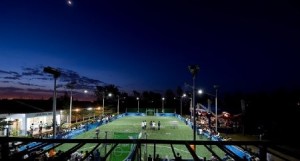Young men in Africa who take part in football must, by and large, do it during the day, when the sun is very hot and the light is harsh. And that’s how it’s always been. Never since the introduction of the game on the continent have they had the option of playing when it’s more sensible, in the cool of the night – unless they happen to perform at a high, professional level, in a league where clubs can afford floodlights.
But could the very thing, the sun, that causes them such discomfort during the day, be the answer to playing at night? In a pioneer scheme, solar energy is providing free illumination in disadvantaged communities that would never otherwise aspire to the sort of facilities taken for granted by young people in the West.
This spring (2011) the first solar powered floodlighting scheme was inaugurated at a stadium in Mathare, a poor community on the edge of Nairobi in Kenya, under the “20 Centres for 2010” programme which came out of the 2010 FIFA World Cup in South Africa.
The solar panels, donated by Chinese manufacturer Yingli Green Energy, will provide about 1000 hours of floodlighting in a year, between three and four hours each night. A similar scheme is underway, under the same program, in Rwanda that will also see solar panels fitted to a stadium.
The solar-charged facilities will have an additional social benefit, that of taking bored young men off dark streets at night, and giving them a purpose. The full remit of the centres is to “address local social challenges in disadvantaged areas and improve education and health services for young people.”
Until now the advance of solar power has mainly benefited comfortably-off homeowners in the western world, who can afford the initial high cost of installing panels on their roofs to generate electricity, and businesses, corporations and public sector organisations who fit the systems onto their buildings. And while the scheme at Mathare depends on the generosity of corporate benefactors, it still costs considerably less than linking conventional floodlights to expensive, and uncertain, energy in the grid.
African countries have already demonstrated that they can leapfrog conventional technological advance, for instance through the widespread use of mobile phones (instead of landlines, supported by a costly and cumbersome infrastructure) to communicate, do business and even transfer money and pay bills.
Could the “20 Centres for 2010” scheme be an early part of a revolution in the use of solar power in Africa, in which governments will be able to to dispense with the need to build and develop an expensive national grid based on conventional sources of energy?

